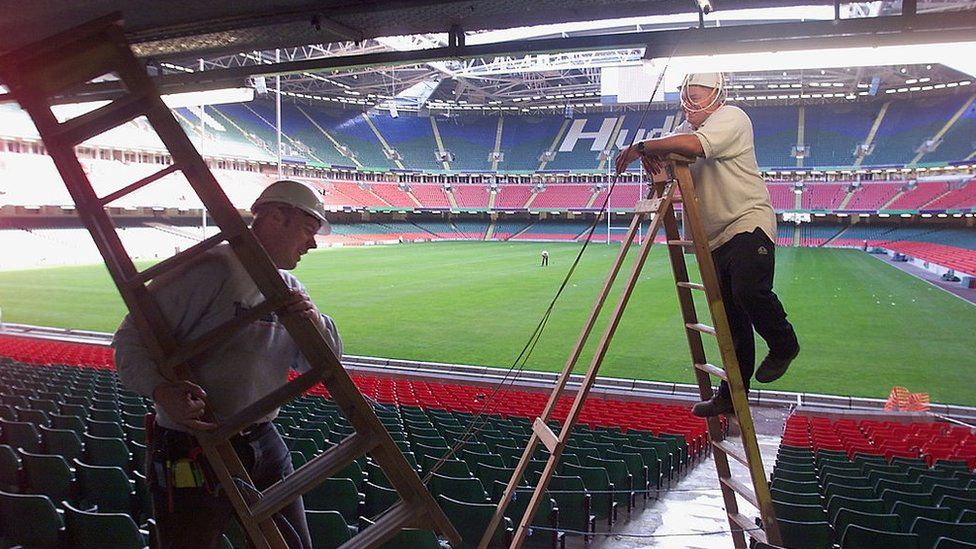Rugby World Cup: When Wales hosted the tournament 20 years ago
- Published
- comments

With the opening ceremony of the 2019 Rugby World Cup in Japan just hours away, excitement is building for another thrilling tournament.
However, the final preparations in Tokyo can surely be nothing compared to the goings-on behind the scenes in Cardiff 20 years ago.
For those involved in delivering the tournament back in 1999, the memories are just as likely to make them shudder as swell with pride.
The question on everyone's lips back then was whether or not the newly constructed £121m Millennium Stadium - now called the Principality Stadium - would even be completed in time.
After much deliberation, including a suggestion it should be built in Bridgend, the decision was made to bulldoze the original National Stadium and build a new venue with a roof on the same site in the centre of Cardiff - all within three years.
It was an epic challenge that brought with it major engineering challenges, such as moving Wales' biggest telephone exchange. Almost inevitably, costs began to overrun.
It all meant the months leading up to the first Rugby World Cup of the professional era became a giant race against time for the host nation.
Russell Goodway, then leader of Cardiff council and deputy chairman of the Millennium Stadium company, felt his political career was intertwined with the success - or failure - of the project because of its importance to the city.
It was only three weeks before the tournament kicked off that he genuinely felt the stadium would be ready.
"I remember on more than one occasion getting to the point of wishing it had been built in Bridgend because it was absolutely nerve-wracking," he said.
"From the moment the project started to the opening ceremony, every component was complex. It was mammoth.
"If you need a GCSE to do the politics, then you need a PhD to understand rugby politics.
"On reflection it was very precarious. There was more than one moment when this could have gone very wrong."
The opening ceremony on 1 October 1999 came just three months after Wales beat South Africa in the half-built stadium.
Mr Goodway said the legal contracts to allow that first match to go ahead were only signed on the morning of the game - a few hours before kick-off.
So concerned was the International Rugby Board, now known as World Rugby, it summoned tournament director and former Wales captain Paul Thorburn to Wembley Stadium for talks over the London venue being a back-up in case the Millennium Stadium was not ready.
"The World Cup would still have happened in the UK but we knew that if this stadium had not been built on time, that would have been catastrophic from a Welsh perspective," said Mr Thorburn.
Building contractor Laing was also in a bind.
The Welsh Rugby Union was only liable for a certain amount so the company would have to absorb any extra costs - which were starting to mount up.
Senior managers were forced to quit after they later admitted the project - dubbed the "Cardiff curse" - had been a "financial disaster" for the firm.
"The contractor had a massive reputation on the line, globally, and therefore they pulled out the stops," said Mr Thorburn.
"They knew they were going to lose massive amounts of money but the PR disaster that would have surrounded them not delivering it was so big that deep down, we were confident it would be delivered on time.
"But there were some hairy moments."
One of those moments came on the day of the ceremony itself when a metal nut fell from the roof of the stadium onto the hand of a steward, prompting health and safety concerns.
And then there was the role of the rugby personalities involved, and no-one is more critical than the then-WRU chairman and driving force, Glanmor Griffiths.
He insists now he never had any doubts he would get the stadium completed in time.
"I always felt I could do it," he said.
"I had my critics and I had my doubters but the only way to silence them was to have it ready on time."
In the end, the stadium was unveiled on time.
Dame Shirley Bassey and Sir Bryn Terfel sang and the Prince of Wales welcomed the world to Wales - and started 20 years of wonderful memories at the stadium.
- Published14 August 2019
- Published26 June 2019
- Published26 June 2019
- Published26 June 2019
- Published25 July 2012
- Published6 June 2003